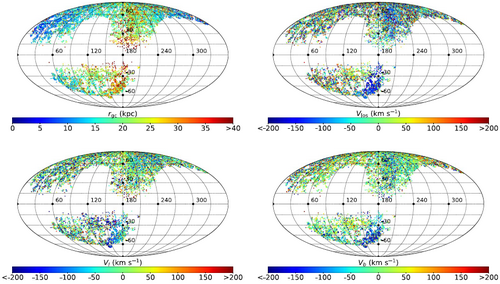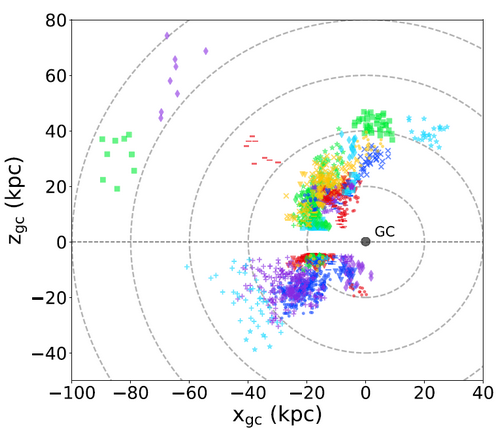Recently, researchers from the National Astronomical Observatories of Chinese Academy of Sciences (NAOC) and their collaborators used ~13000 halo K-giants drawn from LAMOST DR5 to identify more than 40 groups (~2000 stars) belonging to substructures, including known substructures such as Sagittarius Stream, Monoceros Ring, Virgo Overdensity, Hercules-Aquila Cloud, and Orphan Stream and some unknown substructures. The researchers including PhD student ChengqunYang, Prof. Xiang-Xiang Xue, Prof. Gang Zhao and Prof. Chao Liu, etc, presented six-dimensional phase-space parameters for a large sample of substructures in the Galactic stellar halo for the first time. This study presents a more comprehensive view of the Galactic substructure. The results have been published on The Astrophysical Journal.
As prediction of ΛCDM model, galaxies such as the Milky Way are formed by accreting small systems. Therefore, finding and analyzing the substructure in the Milky Way is crucial to understanding the formation of the galaxy. In general, the merger or accretion will leave remnants (substructures) in the surrounding space, appearing as steams, over densities, and shells.
In order to find these substructures (steams, overdensities, and shells), the researchers used the spatial positions and line-of-sight velocities of the LAMOST halo K-giants, combined with proper motions from Gaia DR2, to obtain a catalog of more than 13,000 halo stars with complete six-dimensional phase-space paremeters. It is also the largest catalog of Galactic halo K giants by far with complete phase-space parameters (as shown in Figure 1).

Figure 1. Galactic sky coverage for halo K giants. Stars are colored according to Galactocentric distance r_gc, line-of-sight velocity V_los, and tangential velocities (V_l, V_b).
Researchers found more than 40 groups with similar positions and velocities from the 13,000 halo stars. About 2,000 halo stars belong to substructures (see Figure 2). These stars were obviously more clustered than local halo stars in the space of position and velocity. Besides, 18 groups (~300 stars) of new substructures were discovered, which is probably for the first time.

Figure2. X-Z plane distribution of 43 groups (1867 stars) identified from LAMOST halo K giants.

Address: 20A Datun Road, Chaoyang District, Beijing, China code: 100012
Tel: 010-64888708 E-mail: naoc@nao.cas.cn

